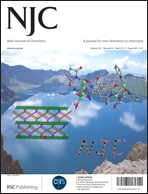The paramagnetic and luminescent [Re6Se8I6]3− cluster. Its potential use as an antitumoral and biomarker agent
Abstract
Success in cancer chemotherapy is based on the selectivity of some drugs to induce tumor cell death without affecting normal cells. In that respect, some metal-based drugs appear to be promising in the development of efficient anticancer agents. Here, we evaluate the efficacy of the anionic hexa-iodo rhenium selenide cluster, Re6Se8I63−, which was predicted some years ago to be luminescent, to selectively increase tumor cell death, leaving non-tumoral cells unaffected. Thus, here we explore its intracellular localization by taking advantage of its revealed luminescence. Comparative studies of the cytotoxic effects of the Re6Se8I63− cluster when exposed to the tumorigenic cell line HepG2, endothelial cell-derived cell line (EA cells) and non-tumor primary endothelial cells (HUVEC) revealed that the cytotoxicity was highest for HepG2 and lowest for HUVEC. In addition, cells tend to uptake the cluster into their nuclei, where we found significant evidence of direct non-intercalating DNA binding. Finally, DNA laddering experiments suggested that the cluster induced apoptotic-like cell death. Our results suggest that the Re6Se8I63− cluster could be useful for the development of novel and efficient metal-based antitumor drugs for the diagnosis and treatment of cancers. The findings reported here represent the first attempts of a new and exciting field of research of inorganic multinuclear clusters in cancer research.
![Graphical abstract: The paramagnetic and luminescent [Re6Se8I6]3− cluster. Its potential use as an antitumoral and biomarker agent](/en/Image/Get?imageInfo.ImageType=GA&imageInfo.ImageIdentifier.ManuscriptID=C2NJ21016A&imageInfo.ImageIdentifier.Year=2012)

 Please wait while we load your content...
Please wait while we load your content...